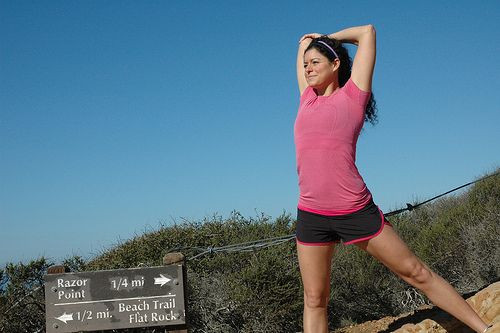Is Sitting The New Smoking? A Workday Of Inactivity Could Offset Any Benefits Of Exercise

If you're anything like the rest of the working world, the 24 hours you're allotted are either spent upright — with a 90-degree bend at the waist — and parked in front of a desk, or they're spent horizontal, asleep. Strip away the ideal eight hours each night, and you're left with half of your waking life spent sitting and, if you're lucky, at least one hour of it spent exercising. Recently, this has prompted researchers to ask: is sitting the new smoking?
It's not quantity or quality. It's both.
Exercise isn't a panacea, the researchers argue. It can't do everything. The hour a smoker spends on the treadmill is no match for the thousands of carcinogens each cigarette pours into her lungs. And while extended periods of sitting have already been known to increase risks for heart disease, diabetes, cancer, and even depression, a growing body of research shows the recommended hour of daily exercise may not be enough to offset the eight hours spent sitting.
Travis Saunders, Ph.D. student and certified exercise physiologist at the Healthy Active Living and Obesity Research Group at Children's Hospital of Eastern Ontario, says the medical community could do well to reexamine what classifies a lifestyle as sedentary.
"Up until very recently, if you exercised for 60 minutes or more a day, you were considered physically active, case closed," he said. "Now a consistent body of emerging research suggests it is entirely possible to meet current physical activity guidelines while still being incredibly sedentary, and that sitting increases your risk of death and disease, even if you are getting plenty of physical activity."
As it turns out, people who exercise end up sitting just as much as their sedentary cohorts — much like two people who both smoke the same number of cigarettes daily. Even if one exercises, the underlying problem is still the cigarettes.
"Smoking is bad for you even if you get lots of exercise," Saunders said. "So is sitting too much."
One study found that regularly active people may end up sitting more than those who don't exercise, as the scheduled block of activity encourages people to spend more time resting.
"We were very surprised that even the highest level of exercise did not matter squat for reducing the time spent sitting," said Marc Hamilton, Ph.D., professor and director of the inactivity physiology department at Pennington Biomedical Research Center and lead author of a 2012 study on sitting duration.
Hamilton's study backed up the claim that active and non-active people spend roughly equal times on their backside. The study found people spent an average of 64 hours a week sitting, 28 hours standing, and 11 hours milling about (non-exercise walking), regardless of whether or not they hit the desired activity mark of 150 minutes a week.
In fact, people who exercise are 30 percent less active overall on days when they exercise than days they decide to stay off the treadmill or out of the gym, according to one measurement presented at the 2013 meeting of the American College of Sports Medicine from Illinois State University.
Why is sitting so unhealthy?
Sitting, whether it's at a desk, around a dinner table, or in front of the TV, is very much a modern convention.
Our bodies were never designed to accommodate a position that diminishes the blood flow to our legs and feet and contorts our spine. A much more natural position is squatting, which many prehistoric humans practiced until societies began industrializing and we lost the necessity to squat, both in the workplace and even the restroom. (One exception is China, where many people still squat, as it naturally aligns the spine and intestinal tract.)
But in many places, sitting has replaced squatting. Our bodies have become less flexible, and researchers say the decreased reliance on bodily movement has us paying the price.
"If you're sitting, your muscles are not contracting, perhaps except to type. But the big muscles, like in your legs and back, are sitting there pretty quietly," said Steven Blair, epidemiologist and professor of public health at the University of South Carolina. This inactivity then causes the metabolism to slow down. Cholesterol levels go up, blood sugar spikes, and triglycerides — which are components of fat — rise as well.
The long-term effects are equally as severe. Separate from Hamilton's research, experts at the Pennington Biomedical Research Center performed a 12-year study on 17,000 Canadians aged 18-90. They found that regardless of age, body weight, or exercise levels, people who spent more time sitting ended up dying earlier.
"We just aren't really structured to be sitting for such long periods of time," said the late Dr. Toni Yancey, who worked as professor in the health services department at the University of California, Los Angeles. "And when we do that, our body just kind of goes into shutdown."
Get up and move.
The solution many doctors advise to combat sitting-related health problems is simply to take breaks. The occasional stretch or walk down the hallway can reinvigorate the muscles enough to spike your metabolism and increase blood flow to the limbs.
"Even breaks as short as one minute can improve your health," said Stuart McGill, Ph.D., director of the Spine Biomechanics Laboratory at the University of Waterloo, adding that frequent postural changes also help the body stay mobile.
Frequent runners and exercise enthusiasts should take special heed, as some experts point to decreased performance as a result of extended sitting. Instead of crashing after a long run or an intense workout, gradually diminish your amount of movement throughout the day, experts advise. Your muscles will thank you.
"The static sitting position can cause certain muscles to become tight or overstretched," said Nikki Reiter, biomechanist with The Run S.M.A.R.T. Project, "neither of which is good for your running."



























